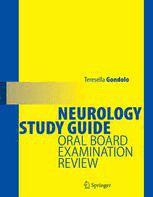
Neurology Study Guide: Oral Board Examination Review PDF
Preview Neurology Study Guide: Oral Board Examination Review
Neurology Study Guide Neurology Study Guide Oral Board Examination Review Teresella Gondolo, MD LibraryofCongressCataloging-in-PublicationData Gondolo,Teresella. Neurologystudyguide : oralboardexaminationreview / Teresella Gondolo. p. ; cm. Includesbibliographicalreferencesandindex. ISBN0-387-95565-8(s/c : alk.paper) 1. Neurology—Examinations,questions,etc. 2. Physicians—Licenses—UnitedStates—Examinations—Studyguides. [DNLM: 1. Neurology—ExaminationQuestions. WL18.2G637n2005] I. Title. RC346.G655 2005 616.8(cid:2)076—dc21 2002029449 ISBN0-387-95565-8 Printedonacid-freepaper. (cid:3)2005SpringerScience(cid:4)BusinessMedia,Inc. Allrightsreserved.Thisworkmaynotbetranslatedorcopiedinwholeorinpartwithoutthewrittenpermission of the publisher (Springer Science(cid:4)Business Media, Inc., 233 Spring Street, New York, NY 10013, USA), exceptforbriefexcerptsinconnectionwithreviewsorscholarlyanalysis.Useinconnectionwithanyformof information storage and retrieval, electronic adaptation, computer software, or by similar or dissimilar methodologynowknownorhereafterdevelopedisforbidden. Theuseinthispublicationoftradenames,trademarks,servicemarks,andsimilarterms,eveniftheyarenot identified as such, are not to be taken as an expression of opinion as to whether or not they are subject to proprietaryrights. Whiletheadviceandinformationinthisbookarebelievedtobetrueandaccurateatthedateofgoingtopress, neithertheauthorsnortheeditorsnorthepublishercanacceptanylegalresponsibilityforanyerrorsoromissions thatmaybemade.Thepublishermakesnowarranty,expressorimplied,withrespecttothematerialcontained herein. PrintedintheUnitedStatesofAmerica. (APEX/EB) 9 8 7 6 5 4 3 2 SPIN10890928 springeronline.com Preface The idea of a book to help neurologistspreparefortheoral partoftheNeurologyBoard Examination stemmed from numerous exchanges with colleagues on how they prepared for this important exam. Nobody seemed to have the magic formula to maximize their chancesofpassingandtherewerewidedisparitiesofopiniononwhattheyconsideredthe best preparation. Some recommendations were based on often inaccurate impressions, otherswerethedistortedproductoftheirstressfulexperiencewhiletakingthetest.Onone thing everyone seemed to agree: There is not a single book available that systematically addressesthespecificsofthiscruciallyimportanttest. The task was daunting because the scope of knowledge required to pass the test is as wide asthe fieldofclinicalneurologyitself.Tomakeitrelevanttotheexperienceofthe test it was clear that a good preparation needed to be based on practical advice on the technical aspects of the exam as well as on the proper attitude in taking it. Moreover, fillingavoidinthecurrentneurologyliterature,anadequatepreparationhadtobebased oncasesandtheirdiscussiononevidence-basedclinicalliterature. Although primarily conceived for neurologists preparing for part 2 of the exam, this bookintendstoprovideinterestingcase-basedmaterialtopracticingadultandchildneu- rologists,educators,academicians,supervisors,residents,andmedicalstudents. The book is divided into two parts. Part 1 is devoted to practical tips on the exam’s structure,itsetiquette,andpreparation.Particularemphasisisplacedonreasonsforfailing the exam. Part 2 concerns itself with the adult and pediatric vignettes part of the oral Board. Each vignette is presented in a format similar to the one candidates find at the exam. The case is then comprehensively formulated with a differential diagnosis, most likely diagnosis, and treatment recommendations. Where relevant, potential pitfalls, dos and don’ts, musts and shoulds, and frequently asked questions complement the case discussion. TERESELLAGONDOLO,MD Foreword WhatmanyNeurologyresidentsdonotrealizeisthattheyarepreparingfortheoralboard examinationeveryday.Presentationsatrounds,atconferences,andeveninformaldiscus- sions regarding differential diagnosis and potential treatment plans are the “stuff” of the oralboards.Anxietyabouttheboards,however,iscommontoalmostalltrainees.Andis doesn’t seem to get better even with increasing clinical experience. One reason for this anxietyisthattheBoardsareshroudedbyaveilofanecdotalexperiencesandmyth,passed down with a variable degree of embellishment and probably a lot of inaccuracy. In fact, theyareahighlystructuredandpracticalexerciseinassuringthebasiccompetencenewly mintedNeurologists. Thereisnomagicformulaforpassing—solidtraining,broadexperienceandclearthink- ingareallbasicrequirements.Butaprescriptionforfailureisalackofpreparation,which ideally includes not only knowledge of Neurology, but also an understanding of what is expected by the examiners. The exam structure provides relatively little time to present oneself (to a group of strangers, no less) as a competent and caringphysician.Preparing for this interaction is essential. Many training programs have instituted mock oral board examinationinordertobetterpreparetraineesspecificallyfortheexam.Aformalsyllabus forthisexercisehasbeenlacking. In this book Dr. Gondolo provides that syllabus, with a clear description of what to expectwhentakingtheboards,andpracticalguidelinesforhow(andhownot)toapproach the exam. Examinees should pay careful attention to Part I, the part not covered during clinical Neurology training. Here Dr. Gondolo outlines clearly the structure of the oral board exam, including information on the examiners themselves:who arethey andwhat aretheirexpectations?Thisisalsoaguidebookof“dos”and“don’ts”fortheexamprocess thatshouldbetakenseriously.Forexample,dressinabusinesslikefashion,getsufficient sleep before the exam, never argue with your examiner, and (when possible) focus your discussionontopicsforwhichyouhavesignificantknowledge. Thesectionon“ReasonsforFailing”providesusefultest-takingtipsevenforthesmartest andmostaccomplishedNeurologists.Dr.Gondoloremindsusthattheapproachtoa“case” in Neurology should always be structured and organized. Follow this path with each and everycase:1)localization,2)differentialdiagnosis,3)diagnosticworkup,and4)manage- ment plans. Straying from this path puts you at risk for overlooking essentialinformation thatcould beimportantin convincing theexaminerofyourcompetence.Perhapsthemost important function of the Boards is discussed under the heading of “The safety factor.” First and foremost, the examiner is charged with the task of weeding out unsafe practi- tioners. Think carefully before suggesting a diagnostic test that may be risky, and never jump to a trivial diagnostic conclusion without first systematically excluding the more seriousconsiderations. PartIIisaconciseandsensiblestudyguideofNeurologicdisordersandtreatmentsthat servesasareviewforboardexaminees,butalsoasateachingtoolandreferenceguidefor more junior trainees and medical students. The case studies presented are typical of those that may be encountered during the Vignette portion of the exam, and thus are good tools forstudy. WhatadvicecanIprovidefortheNeurologistaboutthetaketheoralboardexams?Prepare well,playtoyourstrengths,beconsiderateofyourpatientsandyourexaminers,andgeta goodnight’srest.You’vetrainedlongandhardforthismoment—makethemostofit! JONATHAND.GLASS,M.D. ProfessorofNeurologyandPathology Director,NeurologyResidencyTrainingProgram EmoryUniversitySchoolofMedicine Atlanta,Georgia Contents Preface........................................................................................................ v Part1 1 GeneralInformation................................................................................ 3 TheCandidate........................................................................................ 3 PresentingYourself.............................................................................. 3 TheDayYouArrive............................................................................. 4 TheExaminers....................................................................................... 4 StructureoftheExaminingTeam........................................................... 4 TrainingofExaminers.......................................................................... 4 HowExaminersPlanfortheSession....................................................... 4 Grading............................................................................................. 5 YourInteractionwiththeExaminers....................................................... 5 TheAnxietyFactor................................................................................. 6 HintsforDealingwithAnxiety.............................................................. 6 InformationontheBoard......................................................................... 6 2 TheLivePatientExamination................................................................... 9 TheRoom............................................................................................. 9 TheTimeFactor:30-MinuteHistoryandNeurologicalExamination................ 9 TheToolBox(YourMedicalInstruments)................................................... 10 ThePatient............................................................................................ 10 DifferentialDiagnosisandDiscussionofTreatmentOptions........................... 10 YourInteractionwiththePatient............................................................ 10 TheDifficultPatient............................................................................. 11 The30-MinuteNeurologicalHistoryAndExamination.................................. 12 TheArtofHistoryTaking..................................................................... 12 TheNeurologicalExamination............................................................... 12 The30-MinuteCaseDiscussionandAdditionalQuestions............................. 13 3 TheVignette.......................................................................................... 15 AdultVignettes....................................................................................... 15 HowtoApproachaVignette................................................................. 15 AdultVignetteTopics(Varies)............................................................... 16 TheLastTenMinutes........................................................................... 17 TheCandidateWithoutaClue............................................................... 18 ThePediatricVignette.............................................................................. 19 AgeCategories.................................................................................... 19 4 HowtoPreparefortheExam.................................................................... 21 Courses................................................................................................. 21 Books................................................................................................... 22 Practice................................................................................................. 22 5 ReasonsforFailing................................................................................. 25 ACandidate’sStory................................................................................ 25 viii Contents TheSafetyFactor.................................................................................... 26 TheInformationFactor............................................................................ 26 TheDifferentialDiagnosisFactor.............................................................. 26 LocalizationoftheLesion..................................................................... 26 DeterminingtheTemporalFactor........................................................... 26 PoorPlanningandTreatment.................................................................... 26 TheVariabilityFactor.............................................................................. 27 Part2 6 PeripheralNervousSystemDisorders......................................................... 31 MotorNeuronDisease............................................................................. 31 AmyotrophicLateralSclerosis............................................................... 31 ProgressiveMuscularAtrophy............................................................... 32 BulbarPalsy....................................................................................... 34 Kennedy’sSyndrome........................................................................... 35 PeripheralNeuropathies........................................................................... 36 Guillain-Barre´ Syndrome...................................................................... 36 ChronicInflammatoryDemyelinatingPolyradiculoneuropathy..................... 38 MillerFisherSyndrome........................................................................ 40 DisordersoftheNeuromuscularJunction.................................................... 42 Botulism............................................................................................ 42 Lambert-EatonMyasthenicSyndrome..................................................... 43 MyastheniaGravis............................................................................... 45 BrachialPlexopathy............................................................................. 47 FemoralNeuropathy............................................................................. 48 PostpartumPlexopathy......................................................................... 48 MononeuritisMultiplex........................................................................ 49 InflammatoryMyopathies......................................................................... 50 Polymyositis....................................................................................... 50 Dermatomyositis.................................................................................. 52 InclusionBodyMyositis....................................................................... 52 7 CerebrovascularDisorders........................................................................ 57 SinusThrombosis................................................................................... 57 SagittalSinusThrombosis........................................................................ 57 SubarachnoidHemorrhage........................................................................ 59 CerebellarHemorrhage............................................................................ 61 Cerebal(Lobar)Hemorrhage..................................................................... 62 PosteriorCirculationDisorders.................................................................. 63 Wallenberg’sSyndrome........................................................................ 63 VertebrobasilarArterySyndrome............................................................ 64 ProximalBasilarArteryOcclusion.......................................................... 65 PosteriorCerebralArteryInfarction........................................................ 66 Weber’ssyndrome............................................................................... 67 CarotidArteryDisease............................................................................. 67 CarotidArteryDissection......................................................................... 68 CarotidCavernousFistula........................................................................ 69 TemporalArteritis................................................................................... 69 StrokeTherapy....................................................................................... 70 8 MovementDisorders............................................................................... 75 MultipleSystemAtrophy......................................................................... 75 ProgressiveSupranuclearPalsy.................................................................. 76 Wilson’sDisease..................................................................................... 77 Contents ix Parkinson’sDisease................................................................................. 78 DementiawithLewyBodies..................................................................... 81 Pick’sDiseaseandFrontotemporalDementia............................................... 82 Huntington’sDisease............................................................................... 83 9 Tumors................................................................................................. 87 PinealTumors........................................................................................ 87 AcousticNeuroma................................................................................... 88 PituitaryAdenoma.................................................................................. 89 PseudotumorCerebri............................................................................... 89 LimbicEncephalitis................................................................................. 91 MeningealCarcinomatosis........................................................................ 92 ParaneoplasticCerebellarDegeneration....................................................... 93 OlfactoryGrooveMeningioma.................................................................. 94 10 Infections.............................................................................................. 97 HerpesSimplexEncephalitis..................................................................... 97 HerpesZosterVasculitis........................................................................... 98 ProgressiveMultifocalLeukoencephalopathy...............................................100 Creutzfeld-JacobDisease..........................................................................101 LymeDisease.........................................................................................102 Neurocysticercosis..................................................................................104 CytomegalovirusPolyradiculopathy...........................................................105 ParasiticInfections..................................................................................106 HTLV-1Myelopathy...............................................................................107 11 HeadacheandFacialPain.........................................................................111 PainfulOphthalmoplegia..........................................................................111 SubduralHematoma................................................................................113 MigraineHeadache.................................................................................114 ClusterHeadache....................................................................................117 TrigeminalNeuralgia...............................................................................118 FacialPalsy...........................................................................................119 12 AdultSeizures,Neuro-otology,andSleepDisorders......................................123 NewOnsetSeizuresinAdults...................................................................123 TemporalLobeEpilepsy...........................................................................124 StatusEpilepticusinAdults......................................................................126 MeniereSyndrome.................................................................................. 127 Narcolepsy.............................................................................................129 13 MultipleSclerosis...................................................................................133 MultipleSclerosis...................................................................................133 OpticNeuritis.........................................................................................136 SyringomyeliaandSyringobulbia..............................................................137 TransverseMyelitis.................................................................................139 14 NeurologicalComplicationsofSystemicDisorders.......................................141 Wegener’sGranulomatosis........................................................................141 NeurologicalComplicationsofRheumatoidArthritis.....................................142 NeurologicalComplicationsofMalabsorption..............................................143 NeurolepticMalignantSyndrome............................................................... 144 VitaminB Deficiency............................................................................145 12 NeurologicalComplicationsofDiabetes......................................................146 x Contents 15 ToxicandMetabolicDisorders..................................................................149 Wernicke-KorsakoffSyndrome..................................................................149 DeliriumTremens...................................................................................150 ToxemiaofPregnancy.............................................................................150 16 PediatricEpilepsy...................................................................................153 NeonatalSeizures...................................................................................153 InfantileSpasmsandTuberousSclerosis.....................................................155 AbsenceSeizures....................................................................................157 FebrileSeizures......................................................................................159 JuvenileMyoclonicEpilepsy.....................................................................160 Lennox-GastautSyndrome........................................................................161 BenignChildhoodEpilepsywithCentrotemporalSpikes................................163 StatusEpilepticus....................................................................................164 17 PediatricBrainTumors............................................................................ 167 BrainstemGlioma...................................................................................167 18 PediatricNeuromuscularDisorders.............................................................169 HypotonicInfant.....................................................................................169 SpinalMuscularAtrophyType1............................................................171 SpinalMuscularAtrophyType2............................................................171 SpinalMuscularAtrophyType3............................................................171 MuscularDystrophies..............................................................................171 Duchenne’sMuscularDystrophy............................................................171 OtherMuscularDystrophies..................................................................173 Dermatomyositis.....................................................................................174 InfantileBotulism...................................................................................175 NeonatalTransientMyastheniaGravis........................................................176 Charcot-Marie-ToothDisease....................................................................176 FacioscapulohumeralMuscularDystrophy...................................................178 MyotonicDystrophy................................................................................179 PeriodicParalysis....................................................................................180 Fabry’sDisease......................................................................................181 MetabolicMyopathies..............................................................................182 McArdle’sDisease...............................................................................182 AcidMaltaseDeficiency.......................................................................183 19 MitochondrialDisorders...........................................................................187 MitochondrialEncephalomyopathy............................................................187 SleepDisorders:Kleine-LevinSyndrome.................................................... 188 CongenitalDefects:Mobius’Syndrome...................................................... 189 20 PediatricAtaxia......................................................................................191 Ataxia-Telangiectasia...............................................................................191 Friedreich’sAtaxia..................................................................................192 PosteriorFossaTumorasCauseofChronicAtaxia.......................................193 AcuteAtaxia..........................................................................................194 21 PediatricCerebrovascularDisorders...........................................................197 ParadoxicalEmboli................................................................................. 197 Homocystinuria......................................................................................199 CerebralHemorrhage...............................................................................200 AcuteHemiplegia...................................................................................201 SubduralHematoma................................................................................202
